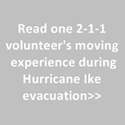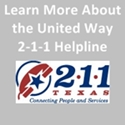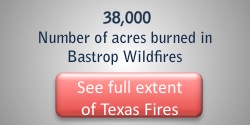When wildfires blazed through Central Texas last month, United Way Capital Area began responding to families almost immediately. Unlike a hurricane which provides plenty of advance notice, a wildfire rages without warning. Lives change within minutes during a disaster and communications become paramount.
The wildfires were this year’s first major disaster in Central Texas in which nonprofits, government agencies and communities turned to social media and the United Way 2-1-1 Teaxs Helpline to communicate and coordinate activities. Even as people were leaving – and in some cases losing – homes they depended on sites like Facebook and Twitter as well as other online resources for information on where to find direction, help, shelter and food.
To provide information to those affected by the wildfires, United Way Capital Area employed social media to share messages about shelters, services and resources available to communities in our area. Now that the initial crisis is over, we are using social media and our United Way 2-1-1 Helpline to facilitate the rebuilding of affected areas and support ongoing collaborations that address future disasters efficiently and effectively.
Using Social Media as an Information Gathering Tool
Whether you were in the wildfire's path or not, you probably took a few minutes to think about what you would take, where you would go and how you would fare if you were forced to evacuate in seconds. The one constant that everyone would want is good, reliable, verified information.
Social media is a great tool for sharing information and observations—especially in times of crisis and when formal communications structures don’t exist, such as in small towns like Bastrop and Spicewood. All reports spread quickly, particularly when people are panicked and worried. When the wrong information is posted it causes confusion, frustration, sometimes distrust and often more difficulty.
When the wildfires broke out, 2-1-1 Texas operators received numerous calls about disaster-related concerns: evacuation information, where to store livestock, how to get a hotel voucher, when they could apply for financial assistance and where they could get food. When you call 2-1-1 and select option one the professional helpline staff will explain our services, listen, problem solve, empower and provide detailed information about community, government and faith-based services.  While 2-1-1 Texas has a plan in place to respond to hurricanes, wildfires were a new challenge.
While 2-1-1 Texas has a plan in place to respond to hurricanes, wildfires were a new challenge.
United Way Capital Area saw the need to quickly capture, verify and share reliable information, in particular as more and more rumors began to spread and grow. The wildfires were different from other natural disasters that we’ve responded to because they were so unexpected and no one had planned a response, so resources were being mobilized every second by leaders throughout the community and we needed to get the word out. To supplement our existing databases, we began to use social media as an information-gathering tool. We had a team on Facebook, Twitter and YouTube gathering data, along with a team checking ten to 12 websites each hour for updates on information and services.
As we searched for news electronically, another team verified every detail before it was disseminated. Where there were discrepancies, we called authorities and received official word on what should be shared. By doing this, we were able to maintain direct interaction with the community, even as people were evacuating and the fires blazed, and provide up-to-the-minute information that we knew could be trusted.
Disseminating Crucial Wildfire Information
 |
With our existing databases bolstered by extensive online research, the success of disseminating verified information relied on two key strategies: finding where the conversations were happening in the social sphere and engaging influencers, namely media, to amplify our message.
By following the Twitter hash-tag #CentralTXFires and using it appropriately, we were able to get our messages out in front of people already interested in what was happening at that moment. We also tagged the Central Texas Wildfire Recovery page on Facebook as it was a central hub for information on that social platform. We worked diligently to connect to existing online discussions and add value so users would want to share, re-tweet, like and provide commentary. It worked: the right information began to spread across the social sphere.
As we verified information, it was critical we share it with the community and let them know where to turn for verified and reliable information. That source was the United Way 2-1-1 Helpline.
Knowing the media were a key source of information, we @replied to them with key messages, particularly about the United Way 2-1-1 Helpline and its role as a hub for reliable, updated information. They then re-tweeted our messages to their followers and helped get accurate information out to people who needed it most. Those followers then re-tweeted about accurate information on the United Way 2-1-1 Helpline and the message grew.
Since the wildfires sparked, our online communities of volunteers and donors have increased dramatically. In addition to the growth in Facebook and Twitter communities, we launched our first Text-to-Give campaign to support wildfire victims. In the first two days of the campaign, we received more than $2,000 in donations when people texted WILDFIRE to 85944.
These online communities, which continue to communicate and engage even after the fires are extinguished, will drive our ongoing recovery work. To date, we've raised more than $117,000, including a very generous relief fund gift from Samsung. All the money goes to those in immediate need and those needing long-term recovery help.
Social Media as a Tool in Long-term Recovery
Even though the information has stabilized since the early days of September, it continues to change quickly. Our role has shifted from disaster response to long-term recovery. This is where United Way Capital Area really steps up.
When many of the disaster relief organizations finish their work, United Way is on hand to help provide and coordinate ongoing recovery for individual families as well as communities. We continue to work closely with the BastropRelief.org website to share information during the ongoing recovery and planning for long-term rebuilding efforts. We also coordinate with those in Spicewood to ensure people in need have access to gas, groceries, shelter and tools so they're able to return to work.
Most importantly, the United Way 2-1-1 Helpline continues to take calls. 2-1-1 Texas continues to be heavily involved with wildfire recovery efforts and remains available 24/7 to connect callers to critical resources such as:
- Evacuation and shelter information for those without
- homes
- FEMA
- application
- assistance
- Basic
- needs and ongoing social services
- assistance
- Mental
- health
- services
- Debris
- clean-up
- information
- Case
- management
- Volunteer
- and donation
- information
- Lost
- pet and livestock evacuation and recovery
- information
- Legal
- aid
During the wildfires, social media provided unprecedented networks to gather, verify and disseminate information. These tools bridged critical gaps, united communities and made critical connections. United Way Capital Area received calls from so many grateful people, including emergency response officials, for providing one source of verified, confirmed, accurate information. Even FEMA emailed with compliments on United Way 2-1-1 Helpline's ability to vet information and act as a gatekeeper for verified facts and services.
As we continue to move into recovery, we will identify ways to use social media tools as we engage neighbors and coordinate nearby community volunteers for clean-up efforts.
This is only the beginning, and United Way Capital Area is committed to not only having a strong presence during disaster situations, but most importantly, supporting communities through the long haul. The wildfire recovery process aligns directly with United Way’s core areas of focus—education, income and health. We will play a key role in getting people back to work and making sure their kids are healthy and successful.
We are developing new ways to use tools like Facebook more strategically during disasters and long-term recovery and brainstorming about the possibilities of having a central place for communication. Perhaps this could materialize in the future as a Facebook page dedicated to wildfire information when new fires are burning. Regardless, social media tools will be key components in restoring communities affected by these wildfires. We want to ensure community leaders understand the 2-1-1 Texas Helpline system that Central Texas has in place and see how it fits in with their local efforts.






